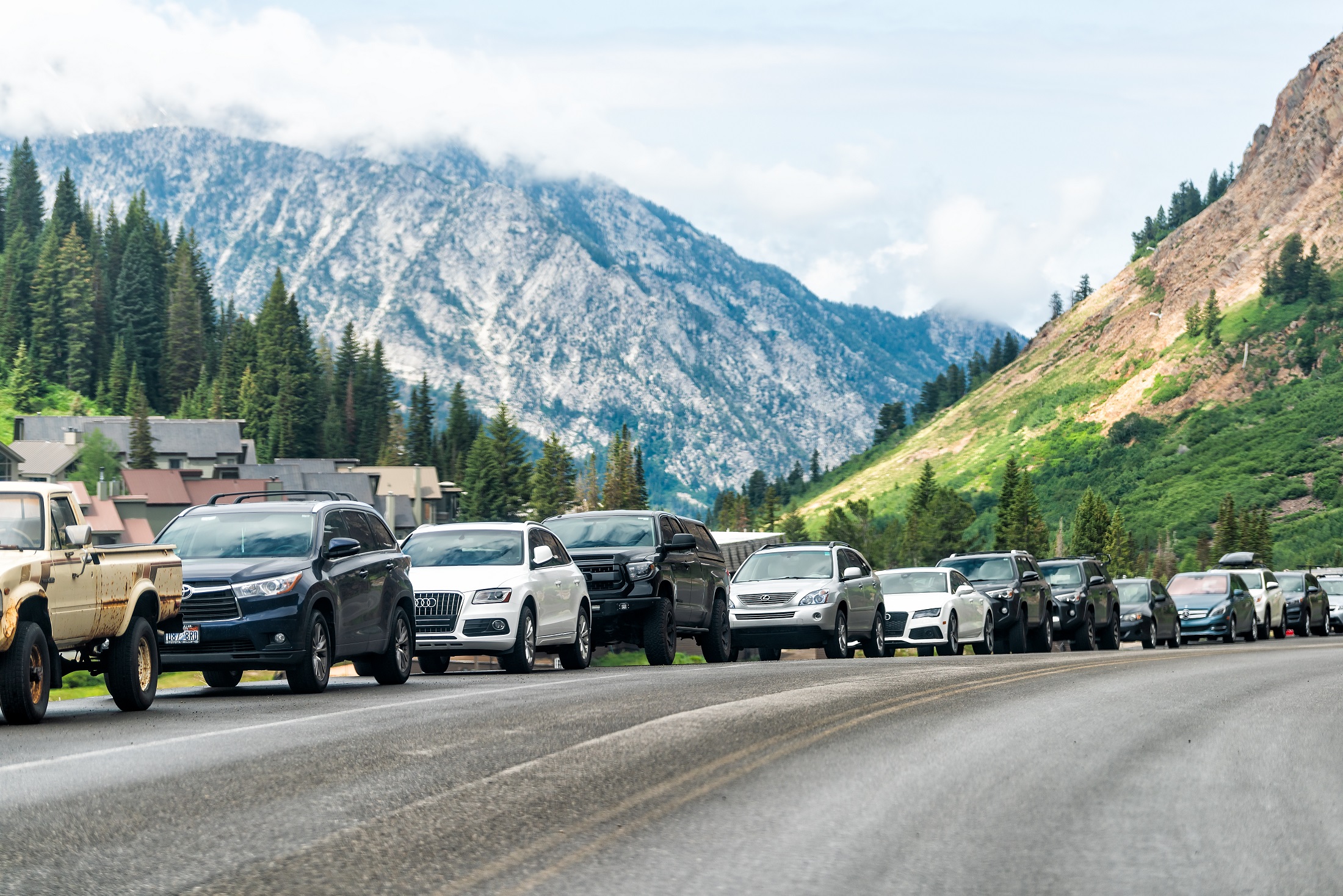An expensive ski transportation project is set to obliterate many of Little Cottonwood Canyon’s idyllic roadside boulders. As the public comment period closes, climbers prepare for the worst.
Snowbird and Alta ski resorts perch at the top of Salt Lake City’s Little Cottonwood Canyon. Alongside the 10 miles of winding road that lead back down to the city sit a plethora of granite blocks sacred to boulderers. Soon, a sweeping transportation project designed to serve the resorts will destroy many of them.
Roadside Bouldering in Little Cottonwood Canyon at Stake
The Utah Department of Transportation (UDOT) is in the final stages of approving either a massive gondola or a bus-only lane expansion in Little Cottonwood Canyon. Either of the $500-million-plus solutions could alleviate the heavy traffic the canyon experiences at the height of ski season — but it will also alter the canyon for good.
Any taxpayers not invested in the success of Snowbird or Alta will also grit their teeth, as either project will reportedly be publicly funded.
In response, the Salt Lake Climbers Alliance (SLCA) has advocated for solutions involving increased or incentivized bussing and tolls for passenger cars. The solution is not as extensively planned as UDOT’s proposals, but it would be more flexible and less invasive to the canyon’s multiple user groups.
To that end, it’s worth noting that the bus lane or gondola would not service backcountry skiers, only paying in-bounds skiers at the resorts.
UDOT closes the public comment period on September 3. At that time, it will decide between the gondola and bus lane and submit the project to the state legislature. If you want to submit a comment to UDOT now, you can do so at the Salt Lake Climbers Alliance website.
View this post on Instagram
The “Why?”: Heavy Ski Season Traffic
It’s 10 miles from the park-and-ride at the base of the canyon to the Snowbird parking lot. In typical conditions, it’s a 20-minute drive. But on powdery weekend afternoons in mid-winter, the trip can take hours.
SR-210 is currently a snaking, two-lane road. Aside from the various pullouts along the way, there’s nowhere for traffic to go but down or up.
UDOT’s plans seek a solution.
The Gondola: Emissions Savings, but a Massive Footprint
At 8 miles long, UDOT’s proposed gondola would be the world’s longest such structure by 2.5 miles — which means it would also necessitate a lot of support structure.
It would require a 1,800-car parking structure at the mouth of the canyon and cable towers that the department can only build and maintain with new access roads cut toward the canyon walls.
However, the energy savings estimates seem impressive. Gondola Works, a global gondola construction and advocate group, supports the project. (Ironically, it heads its website with a “Save Little Cottonwood Canyon” banner, much like the SLCA.) It estimates peak traffic in LCC at 7,000 cars per day, which would produce around 70 tons of carbon.
It also argues a gondola would be more sustainable than bussing, with a 300% lower CO2 emissions footprint. Finally, its promo video claims the gondola would somehow cut “in-canyon emissions by 56%.”
Bus-Only Lanes: Lateral Road Expansion, Plus a Parking Structure
Buses already shuttle skiers up LCC from the park-and-ride. However, in peak season, they get stuck in traffic, just like passenger cars.
The bus lane proposal adds a special bus-only lane on each side of SR-210 and a parking structure at the base. The project also includes calls for better bussing infrastructure, though specifics aren’t yet available.
‘Irreplaceable’ Boulders in the Crosshairs
At the moment, it’s still unclear exactly which and how many of LCC’s boulders are at risk. But the SLCA compiled a resource that estimates each project would destroy about 30 boulders comprising 130 problems.

It’s not a total loss of bouldering in the canyon — Mountain Project is not a complete resource for the area, and it lists over 700 problems. Still, the granite in the Canyon is wildly unique for climbing. And with many classics quite close to the road, some world-class blocks are bound to be stamped for demolition.
Olympic silver medalist and SLC local Nathaniel Coleman recently weighed in on the issue for the Salt Lake Tribune.
“The thing to realize is that every rock [in LCC] is unique. Every rock is an impossible combination of coincidence,” Coleman said. “The boulders that are going to be destroyed are some of the best boulders in the canyons. They host climbs that are challenging and technical and teach climbers how to move over rock. And they are truly irreplaceable.”
Ambiance and Watershed Impacted, Resorts Benefit
Even if most of the climbing in LCC survives the construction, how will the canyon’s ambiance be altered? Currently, hiking or climbing in the canyon is largely serene.
What would it be like to turn around expecting to view the jagged sub-alpine granite and engulfing forest and stare through a gondola car full of kids eating ice cream instead?
But the UDOT plans may send up the most glaring red flag to taxpayers. Because both plans exclusively support Snowbird and Alta, public funding amounts to a subsidy for the resorts.
It’s important to note that zero canyon visitors, other than those headed to the resorts, stand to benefit from either the gondola or the bus lanes. There are no proposals for trailhead stops under either program, and they reportedly will not serve backcountry skiers.
Finally, widening the road or adding gondola suspension towers would negatively affect the canyon’s surface and groundwater quality. In fact, the water quality in Little Cottonwood Creek has a lot of stakeholders — it’s a major water source for Salt Lake City.
In the current situation, the two-lane road is the most invasive human element in the canyon anywhere below the resorts.
Little Cottonwood Canyon Construction: Are There Alternatives?

No matter what, one of these less-than-ideal plans will be set in motion on September 3, right?
Yes, it’s extremely likely, but no, it’s not set in stone. The SLCA will continue to advocate for its own bus plan — which keeps the current two-lane road — with UDOT.
The Alliance says adding infrastructure that would permanently alter the canyon should only be a last resort after they exhaust all other alternatives. By focusing on a singular goal — getting in-bounds skiers to Alta and Snowbird during the high season — UDOT has bypassed the needs of other users and come up with sweeping plans.
Though the plans are somewhat attractive in terms of efficiency, they’re also expensive and potentially harmful to other users and the environment. SLCA also notes that there are no guarantees that people would use either system because neither one disincentivizes driving.
That’s why its plan involves urging UDOT to shunt aside a sweeping measure in favor of expanding electric bus service and implementing traffic mitigation measures like tolls. In a best-of-all-worlds scenario, some combination of e-bussing and discouraging car travel could decrease traffic and emissions in the canyon without compromising ambiance or natural resources.
To that end, it’s encouraging commenters to support UDOT’s bus proposal but advocate against widening SR-210.
The plan looks like a bit of a hail Mary; admittedly, the hope is that the legislature’s opinion of the public comments supersedes UDOT’s proposal and, in turn, it prohibits the department from widening the road.
Get Involved
Anyone can submit a comment to UDOT and should do so soon if they plan on it: The comment period ends September 3. At that point, UDOT will decide which plan to submit to the legislature.
Utah citizens are encouraged to submit their comments to their elected officials and the transportation department.
UDOT’s own environmental impact analysis and developments about the proposals are available through its dedicated LCC Environmental Impact Statement page.








